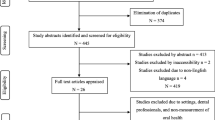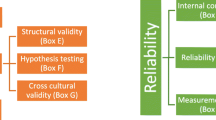Abstract
Background
Limited assessment tools for estimating the oral health of nursing home residents are available in the German language.
Aims
To develop a German version of the Oral Health Assessment Tool (OHAT) and to evaluate test–retest and inter-examiner reliability in use for the assessment of nursing home residents’ oral health by caregivers before and after dental training.
Methods
The original English version of the OHAT was translated into German by a forward–backward translation process. Reliability assessments were conducted in a nursing home (n = 18) by independent application of the OHAT by two trained dentists and four professional caregivers. After receiving dental training, the caregivers repeated the OHAT with the same participants. Reliability analyses of single items were performed using Cohen’s kappa statistics. Intra-class correlations were compiled to assess reliability of the total scores. T tests were used to compare percentage agreement, and under- and overestimation of findings between a reference dentist and the caregivers before and after the training unit.
Results
Specificity and sensitivity of the German OHAT were 87% and 86%. Test–retest reliability of the total OHAT score as estimated by the dentists was excellent (ICC 0.910; 95% CI 0.776–0.965). Before training, mean κ values between the reference dentist and caregivers ranged between 0.155 and 0.912, whereas the inter-examiner reliability of most items was only fair. After training, overall agreement between the dentist and the caregivers improved significantly from 62.1 to 83.1% (p < 0.001), as well as satisfying inter-examiner agreement for the single items.
Conclusions
The German version of the OHAT is a reliable and valid tool for the assessment of oral health conditions of nursing home residents. When used by caregivers, instruction on the tool and practical training are mandatory to ensure reliable estimations. However, further studies with a larger sample size are encouraged to verify the outcomes of this study.
Similar content being viewed by others
References
Adam H, Preston AJ (2006) The oral health of individuals with dementia in nursing homes. Gerodontology 23:99–105
Montal S, Tramini P, Triay JA et al (2006) Oral hygiene and the need for treatment of the dependent institutionalised elderly. Gerodontology 23:67–72
Zenthofer A, Dieke R, Dieke A et al (2013) Improving oral hygiene in the long-term care of the elderly–a RCT. Community Dent Oral Epidemiol 41:261–268
Klotz AL, Hassel AJ, Schröder J et al (2017) Oral health-related quality of life and prosthetic status of nursing home residents with or without dementia. Clin Interv Aging 12:659–665
Schwindling FS, Krisam J, Hassel AJ et al (2018) Long-term success of oral health intervention among care-dependent institutionalized seniors: findings from a controlled clinical trial. Community Dent Oral Epidemiol 46:109–117
Yi Mohammadi JJ, Franks K, Hines S (2015) Effectiveness of professional oral health care intervention on the oral health of residents with dementia in residential aged care facilities: a systematic review protocol. JBI Database System Rev Implement Rep 13:110–122
MacEntee MI, Thorne S, Kazanjian A (1999) Conflicting priorities: oral health in long-term care. Spec Care Dent 19:164–172
Chalmers JM, Pearson A (2005) A systematic review of oral health assessment by nurses and carers for residents with dementia in residential care facilities. Spec Care Dent 25:227–233
Ettinger RL (1987) Oral disease and its effect on the quality of life. Gerodontics 3:103–106
Kiyak HA, Mulligan K (1987) Studies of the relationship between oral health and psychological well-being. Gerodont 3:109–112
Klotz AL, Hassel AJ, Schröder J et al (2018) Is compromised oral health associated with a greater risk of mortality among nursing home residents? A controlled clinical study. Aging Clin Exp Res 30:581–588
Paganini-Hill A, White SC, Atchison KA (2011) Dental health behaviors, dentition, and mortality in the older people: the leisure world cohort study. J Aging Res 2011:156061
Scannapieco FA, Bush RB, Paju S (2003) Associations between periodontal disease and risk for atherosclerosis, cardiovascular disease, and stroke. A systematic review. Ann Periodontol 8:38–53
Nazir MA (2017) Prevalence of periodontal disease, its association with systemic diseases and prevention. Int J Health Sci (Qassi) 11:72–80
Rabbo MA, Mitov G, Gebhart F et al (2012) Dental care and treatment needs of elderly in nursing homes in Saarland: perceptions of the homes managers. Gerodontology 29:e57–e62
Thorne SE, Kazanjian A, MacEntee MJ (2001) Oral health in long-term care: the implications of organizational culture. J Aging Stud 15:271–283
Lin CY, Jones DB, Godwin K et al (1999) Oral health assessment by nursing staff of Alzheimer’s patients in a long-term-care facility. Spec Care Dentist 19:64–71
Andersson P, Halberg IR, Renvert S (2002) Inter-rater reliability of an oral assessment guide for elderly patients residing in a rehabilitation ward. Spec Care Dent 22:181–186
Kayser-Jones J, Bird WF, Paul SM et al (1995) An instrument to assess the oral health status of nursing home residents. Gerontologist 35:814–824
Chalmers JM, King PL, Spencer AJ et al (2005) The oral health assessment tool—validity and reliability. Aust Dent J 50:191–199
Bauer JG (2001) The index of ADOH: concept of measuring oral self-care functioning in the elderly. Spec Care Dentist 21:63–67
Chen HY, Boore JR (2010) Translation and back-translation in qualitative nursing research: methodological review. J Clin Nurs 19:234–239
Sousa VD, Rojjanasrirat W (2011) Translation, adaptation and validation of instruments or scales for use in cross-cultural health care research: a clear and user-friendly guideline. J Eval Clin Pract 17:268–274
Koch L (1977) Measurement for observer agreement for categorical data. Biometrics 33:159–174
Simpelaere IS, Van Nuffelen G, Vanderwegen J et al (2016) Oral health screening: feasibility and reliability of the oral health assessment tool as used by speech pathologists. Int Dent J 66:178–189
Hassel AJ, Leisen J, Rolko C et al (2008) Clinical assessment of oral health between physician and dentist—a pilot study on inter-examiner reliability. Z Gerontol Geriatr 41:132–138
Acknowledgements
We are grateful to all the participants in this study for their patience and cooperation. We would also like to thank Hazel Davies, copy editor, for language revision. Anna-Luisa Klotz was supported by the GEROK program of the University of Heidelberg.
Author information
Authors and Affiliations
Corresponding author
Ethics declarations
Conflict of interest
The authors declare that they have no conflict of interest.
Ethical approval
All procedures performed in studies involving human participants were in accordance with the ethical standards of the institutional and/or national research committee, and with the 1964 Helsinki declaration and its later amendments or comparable ethical standards.
Informed consent
Informed consent was obtained from each participant included in the study.
Additional information
Publisher’s Note
Springer Nature remains neutral with regard to jurisdictional claims in published maps and institutional affiliations.
Rights and permissions
About this article
Cite this article
Klotz, AL., Zajac, M., Ehret, J. et al. Development of a German version of the Oral Health Assessment Tool. Aging Clin Exp Res 32, 165–172 (2020). https://doi.org/10.1007/s40520-019-01158-x
Received:
Accepted:
Published:
Issue Date:
DOI: https://doi.org/10.1007/s40520-019-01158-x






